Sennheiser HMEC 25-6A User Manual
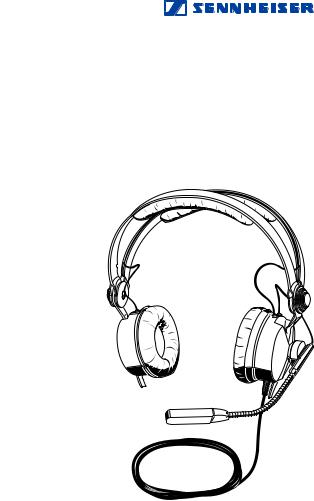
GEBRAUCHSANLEITUNG INSTRUCTIONS FOR USE NOTICE D‘EMPLOI ISTRUZIONI PER L‘USO INSTRUCCIONES PARA EL USO GEBRUIKSAANWIJZING
HMEC 25-6A
025-230-765
HMEC 25-KAP-2
025-230-715




 “
“

Gebrauchsanleitung ............................................................................................... |
3 |
Instructions for use .............................................................................................. |
11 |
Notice d´emploi .................................................................................................... |
19 |
Istruzioni per l´uso ............................................................................................... |
27 |
Instrucciones para el uso ..................................................................................... |
35 |
Gebruiksaanwijzing .............................................................................................. |
43 |
Lärm - wo begegnet er uns nicht?
Ob am Arbeitsplatz, in der häuslichen Umgebung, in öffentlichen Verkehrsmitteln, auf Flug-, Bahnoder Busreisen - eigentlich begleitet er uns überall.
Die negativen Auswirkungen dieser Lärmbelästigungen sind durch Studien belegt und auch jeder von uns wird sie schon gespürt haben:
Nervosität
Konzentrationsmangel
Gereiztheit ...
sind nur die augenscheinlichen Auswirkungen auf den Organismus. Lärm wirkt zudem auf das vegetative Nervensystem und kann zu Dauerschäden des Gehörs führen.
Die Quellen des Lärms sind vielfältig und häufig für den einzelnen nicht abzustellen. Daher kann nur der persönliche Schutz an einem lärmerfüllten Ort eine Lösung darstellen.
Mit dem System NoiseGard™ hat Sennheiser eine wirkungsvolle Lösung realisiert. Das Funktionsprinzip und die Bedienung wird Ihnen in dieser Anleitung erläutert.
Schallpegel von Lärmquellen
|
140 dB |
Düsentriebwerk (25m Entfernung) |
Laut |
130 dB |
Flugzeugmotor |
120 dB |
Druckluftbohrer |
|
|
110 dB |
Schmiedehammer, Betonwerk |
|
100 dB |
Metalldruckgußmaschine |
|
|
|
|
90 dB |
Metallwerkstatt |
|
80 dB |
Traktor |
|
70 dB |
Büro |
|
60 dB |
Unterhaltung |
|
|
|
|
50 dB |
Umweltlärm |
|
40 dB |
Wohnraum |
Leise |
30 dB |
Bibliothek |
20 dB |
Schlafzimmer |
|
|
10 dB |
Wald, windstill |
Die Maßeinheit für Schallpegel ist das Dezibel (dB). Eine Lärmdämpfung um 10 dB wird allgemein als Halbierung der Lautstärke empfunden, weitere 10 dB Dämpfung ergeben eine um 75% reduzierte Lärmempfindung u.s.w.
2 |
3 |
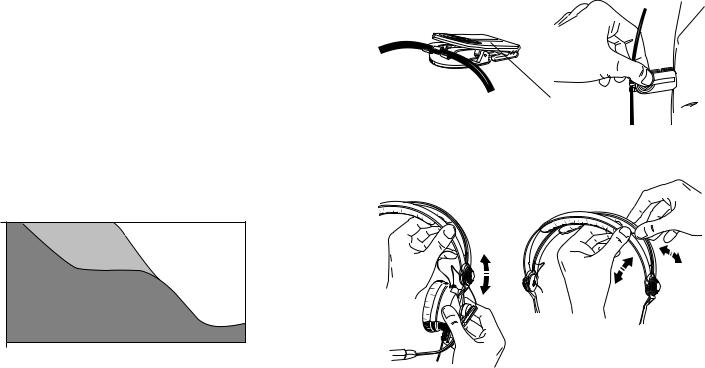
HMEC 25-6A / HMEC 25-KAP-2
Eine Hör-/ Sprech-Garnitur faßt zwei Baugruppen, Kopfhörer und Mikrofon zu einer Funktionseinheit zusammen. Überwiegender Einsatzbereich dieser Hör-/ Sprech-Garnituren HMEC 25-6A/-KAP-2 ist die Kommunikation im Flugzeugcockpit.
Als Mikrofon wird ein hochwertiges dauerpolarisiertes Elektretmikofon benutzt. Die notwendige Versorgungsspannung wird ( gemäß ARINC) über den Anschlußstecker aus dem Bordnetz des Flugzeuges bezogen.
Als Kopfhörer dienen Sennheiser NoiseGard™-Systeme. Dies sind dynamische Hörersysteme, bei denen, zusätzlich zur Wiedergabe eines Audiosignales, auf elektronischem Weg tieffrequenter Störschall kompensiert wird. Die aktive
Lärmkompensation funktioniert nach dem physikalischen Prinzip, daß sich Schall und "Antischall" (um 180° phasenverschoben) gegenseitig auslöschen. Die NoiseGard™-Kompensationselektronik im Kopfhörer benötigt eine gesonderte eigene Stromversorgung, die das fest mit dem Kabel verbundene Speiseteil (Siehe Abbildung S. 6) liefert.
Ungestörte Verständigung wird möglich, ohne die Lautstärke so laut einstellen zu müssen, daß die Umweltgeräusche übertönt werden.
NoiseGard™ erhöht den Komfort,
ist aber kein medizinischer Hörschutz !
Geräuschkompensation mit NoiseGard™
Noise compensation HMEC 25
Reduction/dB
0
10 |
|
|
|
active |
passive |
|
|
|
|||||||
20 |
|
|
|
|
|
|
|
|
|
||||||
|
|
|
|
|
|
|
|
|
|
|
|
|
|
|
|
|
|
|
|
|
|
|
|
|
|
|
|
|
|
|
|
30 |
|
|
|
|
|
|
|
|
|
|
|
|
|
|
|
|
|
|
|
|
|
|
|
|
|
|
|
|
|
|
|
40 |
|
|
|
|
|
|
|
|
|
|
|
|
|
|
|
20 |
100 |
1000 |
10000 |
20000 |
|||||||||||
|
|
|
|
|
|
|
|
|
|
Frequency/Hz |
|||||
Lieferumfang
1 HMEC 25-6A oder HMEC 25-KAP-2 1 Schutzund Transporttasche
1 Windschirm MZW 45 (Art.Nr. 75823)
1 Klemmhalter MZQ 2002-1 (Art.Nr. 44740), s. Abb.
MZQ 2002-1
Kopfbügel einstellen
4 |
5 |

HMEC 25-6A |
HMEC 25-KAP-2 |
NoiseGard™ einund ausschalten
Ist die aktive Lärmkompensation NoiseGard™ ausgeschaltet, können Sie das Headset wie ein ganz gewöhnliches Headset einsetzen.
Schalten Sie das NoiseGard™-System ein, indem Sie den ON/OFF-Schalter in die Position ‚ON’ schieben.
Mono-/Stereo-Umschaltung
Üblicherweise empfangen Sie Ihre Tonquelle in Mono und können den Mono-/ Stereo-Umschalter in der Position ‚Mono’ belassen. Schalten Sie an einem Stereo- Intercom-System den Kopfhörer auf ‚Stereo’ um.
Kabel (rechts oder links)
350°
Kabel links |
Kabel rechts |
Hinweise
NoiseGard™ dient der Geräuschverminderung zur Erhöhung des Komforts.
NoiseGard™ ist kein medizinisches Lärmschutzsystem!
NoiseGard™ ersetzt kein industrielles Lärmschutzsystem zum Einsatz in lärmerfüllter Umgebung!
Laut hören ? - Nein !
Mit einem Kopfhörer wird gern lauter als mit Lautsprechern gehört. Hohe Lautstärke, die über längere Zeit auf Ihre Ohren einwirkt, kann zu dauerhaften Hörschäden führen. Schützen Sie Ihr gesundes Gehör, Sennheiser-Kopfhörer klingen auch bei niedriger Lautstärke besonders gut ...
6 |
7 |
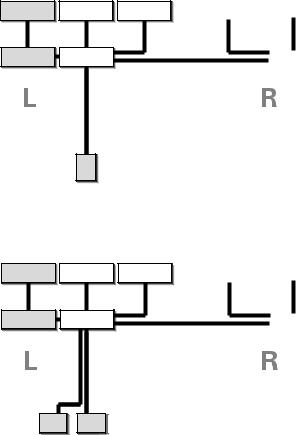
Blockschaltbild HMEC 25-6A
boom |
microphone |
microphone |
amplifier |
headphone |
compensation |
capsule (left) |
microphone (left) |
compensation circuit (left)
compensation |
|
headphone |
microphone (right) |
|
capsule (right) |
|
|
|
|
|
compensation |
|
|
circuit (right) |
|
|
|
6-pin Redel plug
Blockschaltbild HMEC 25-KAP-2
boom |
microphone |
microphone |
amplifier |
headphone |
compensation |
capsule (left) |
microphone (left) |
compensation circuit (left)
PJ 068 |
6,35 mm |
plug |
plug |
compensation |
|
headphone |
microphone (right) |
|
capsule (right) |
|
|
|
|
|
|
|
|
compensation |
|
|
circuit (right) |
Technische Daten NoiseGard™ HMEC 25-6A / HMEC 25 KAP-2
Kopfhörer
Wandlerprinzip |
dynamisch, geschlossen, ohraufliegend |
|
Übertragungsbereich |
16 Hz - 22 kHz |
|
Impedanz |
aktiv/passive |
200 / 180 Ohm (mono) |
|
|
400 / 360 Ohm pro System (stereo) |
|
|
Lautstärke aktiv und passiv gleich |
Klirrfaktor |
|
< 1 % |
Lärmdämpfung aktiv |
15 dB ± 3 dB im Bereich von 100 Hz - 2 kHz |
|
Frequenzbereich der |
|
|
aktiven Lärmdämpfung |
50 - 600 Hz |
|
Mikrofon inkl. Vorverstärker |
|
|
Wandlerprinzip |
Back-Elektret-Kondensatorkapsel, |
|
|
|
geräuschkompensiert |
Übertragungsbereich |
300 Hz - 5 kHz |
|
|
|
entsprechend RTCA/DO-214 |
max. Schalldruckpegel |
120 dB |
|
Ausgangsspannung |
400 mV ± 3 dB bei 114 dB aus 6 mm Abstand |
|
|
|
(entsprechend RTCA/DO-214) |
Abschlußwiderstand |
150 Ohm |
|
Versorgungsspannung |
typ. 16 V DC, ca 8 - 25 mA, |
|
|
|
Beschaltung nach RTCA/DO 214 |
Allgemeine Daten |
|
|
Kopfhörer-Andruckkraft |
ca 2,5 N |
|
Gewicht ohne Kabel |
170 g |
|
Kabel |
|
einseitig, Länge gesamt: 1,8 m |
Stecker |
HMEC 25-6A: |
6-PIN Redel |
|
HMEC 25-KAP-2: |
PJ 068 (Mikrofon) |
|
|
6,35mm Klinkenstecker (Hörer) |
NoiseGard™-Speisung |
12 - 35 V DC |
|
Stromaufnahme |
typ 18 mA |
|
8 |
9 |

The Problem of Noise
The negative effects of noise pollution have been proven by studies, and everybody will have experienced them at some time or another:
Nervousness
Lack of concentration
Irritability
And these are only the most obvious effects on the human body. Noise also affects the autonomic nervous system and can lead to permanent hearing damage.
There are a multitude of noise sources, and the individual very often has no influence over them. The only solution when being in a noisy place is protecting oneself against ambient noise. These noise problems are particularly prevalent in an aircraft cockpit where a pilot often has to have the communications headset so loud as to risk permanent hearing damage.
With the NoiseGard™ system, Sennheiser has come up with an effective solution. These operating instructions explain the NoiseGard™ principle and show you how to use the NoiseGard™ headset.
Noise levels
|
140 dB |
Jet engine (at a distance of 25 m) |
loud |
130 dB |
Aircraft engine (This is the treshold of pain) |
120 dB |
Pneumatic drill |
|
|
110 dB |
Blacksmith's hammer, concrete works |
|
100 dB |
Die-cast machine |
|
90 dB |
Metal workshop |
|
80 dB |
Tractor |
|
70 dB |
Office |
|
60 dB |
Conversation |
|
50 dB |
Ambient noise |
|
40 dB |
Living room |
quiet |
30 dB |
Library |
20 dB |
Bedroom |
|
|
10 dB |
Forest, no wind |
The unit of sound levels is the decibel (dB). A noise reduction of 10 dB is generally perceived as a halving of the loudness, another 10 dB decrease halves the loudness yet again whitch corresponds to a loudness reduction of 75 %, and so on.
10 |
11 |
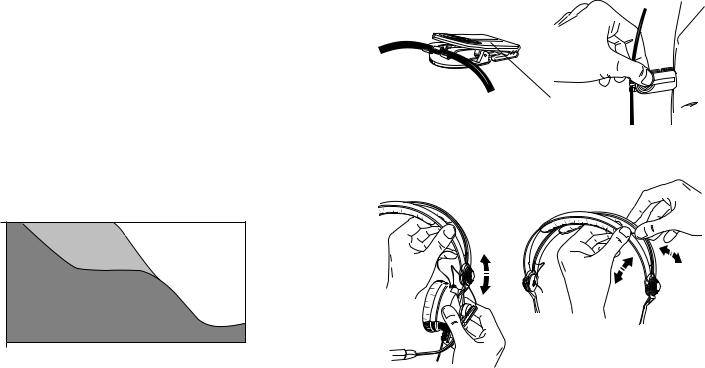
HMEC 25-6A / HMEC 25-KAP-2
A headset is comprised of two units, a headphone and a microphone. The HMEC 25-6A/-KAP-2 headset is mostly used for communication in aircraft cockpits.
The microphone is a high quality back-electret condenser microphone. As per ARINC it receives its operating voltage via a connector from the aircraft´s internal power supply.
The headphone is a Sennheiser NoiseGard™ system. This is a dynamic headphone system which, in addition to reproducing the original audio signal, electronically cancels the low frequencies of the ambient noise. This active noise compensation operates on the principle that sound and ”anti-sound“ (in phase opposition) cancel each other out. The NoiseGard™ compensation circuitry in the headphone requires an extra power supply, so a battery compartment has been integrated into the headset cable (see illustration p. 14).
Clearly intelligible communication is ensured, and the pilot no longer has to turn the volume up to overcome ambient noise.
NoiseGard™ increases your comfort,
but it is not a medical hearing protection!
Active noise compensation with NoiseGard™
Noise compensation HMEC 25
Reduction/dB
0
10 |
|
|
|
active |
passive |
|
|
|
|||||||
20 |
|
|
|
|
|
|
|
|
|
||||||
|
|
|
|
|
|
|
|
|
|
|
|
|
|
|
|
|
|
|
|
|
|
|
|
|
|
|
|
|
|
|
|
30 |
|
|
|
|
|
|
|
|
|
|
|
|
|
|
|
|
|
|
|
|
|
|
|
|
|
|
|
|
|
|
|
40 |
|
|
|
|
|
|
|
|
|
|
|
|
|
|
|
20 |
100 |
1000 |
10000 |
20000 |
|||||||||||
|
|
|
|
|
|
|
|
|
|
Frequency/Hz |
|||||
Supply schedule
1 HMEC 25-6A or HMEC 25-KAP-2 1 Carrying case
1 wind-shield MZW 45 (Art.No 75823)
1 MZQ 2002-1 clip (Art.No 44740), s. fig.
MZQ 2002-1
Adjusting the headband
12 |
13 |

HMEC 25-6A |
HMEC 25-KAP-2 |
Turning NoiseGard™ ON/OFF
With the NoiseGard™ active noise compensation turned off, the headset can be used as a conventional headset.
Turn on the NoiseGard™ active noise compensation by setting the ON/OFF switch to ON.
Mono/Stereo selection
In general, you’ll receive a mono sound source so that the Mono/Stereo switch can remain set to ‘Mono’. When using a stereo intercom system, set the Mono/Stereo switch to ‘Stereo’.
Cable (Worn on left or right side)
350°
Cable on the left |
Cable on the right |
Note:
NoiseGard™ reduces noise and increases comfort.
NoiseGard™ is not a medical noise protection system!
NoiseGard™ cannot replace an industrial ear defender system for use in noisy environments!
Volume up? - No !
When people use headphones, they tend to choose a higher volume than with loudspeakers. Listening with high volume levels for a longer time can lead to permanent hearing defects. Because the NoiseGard™ circuitry is reducing the ambient noise, the headphones can be set at a correspondingly lower level leading to more comfortable hearing conditions so protecting your hearing.
14 |
15 |
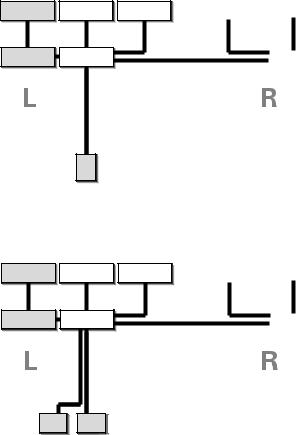
HMEC 25-6A block diagram |
|
|
boom |
headphone |
compensation |
microphone |
capsule (left) |
microphone (left) |
microphone |
compensation |
|
amplifier |
circuit (left) |
|
compensation |
|
headphone |
microphone (right) |
|
capsule (right) |
|
|
|
|
|
compensation |
|
|
circuit (right) |
|
|
|
6-pin Redel plug
HMEC 25-KAP-2 block diagram
boom |
microphone |
microphone |
amplifier |
headphone |
compensation |
capsule (left) |
microphone (left) |
compensation circuit (left)
PJ 068 |
6,35 mm |
plug |
plug |
compensation |
|
headphone |
microphone (right) |
|
capsule (right) |
|
|
|
|
|
|
|
|
compensation |
|
|
circuit (right) |
Technical data NoiseGard™ HMEC 25-6A / -KAP-2
Headphone
Transducer principle |
dynamic, open, supra-aural |
Frequency response |
16 Hz - 22 kHz |
Impedance active/passive |
200 / 180 Ω (mono) |
|
400 / 360 Ω per side (stereo) |
|
same volume for active and passive |
THD |
< 1 % |
Compensation active |
15 dB ± 3 dB between 100 Hz and 2 kHz |
Frequency response of |
|
the active compensation |
50 - 600 Hz |
Microphone incl. preamplifier |
|
Transducer principle |
Noise-compensated back-electret condenser |
|
microphone capsule |
Frequency response |
300 Hz - 5 kHz (as per RTCA/DO-214) |
Max. sound pressure level |
120 dB |
Output voltage |
400 mV ± 3 dB at 114 dB |
|
and a distance of 6 mm |
|
(as per RTCA/DO-214) |
Terminating impedance |
150 Ω |
Operating voltage |
typ. 16 V DC, approx. 8 - 25 mA, |
|
connections as per RTCA/DO 214 |
General data |
|
Contact pressure |
approx. 2.5 N |
Weight without cable |
170 g |
Cable |
single-sided, total length 1.8 m |
Connectors HMEC 25-6A: |
6-PIN Redel |
HMEC 25-KAP-2: headphone: 6.35 mm (1/4") jack plug |
|
|
microphone: PJ-068, 5.25 mm |
Power supply NoiseGard™- |
12 - 35 V DC |
Current consumption |
typ. 18 mA |
16 |
17 |
